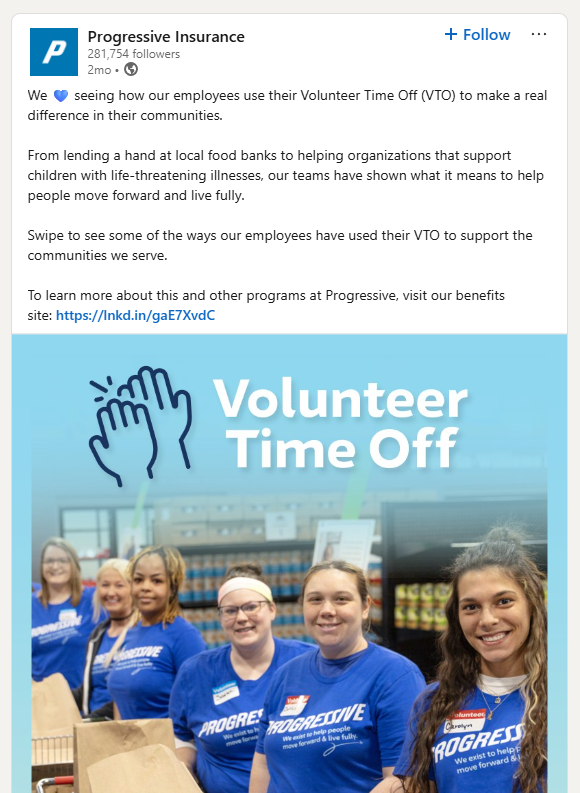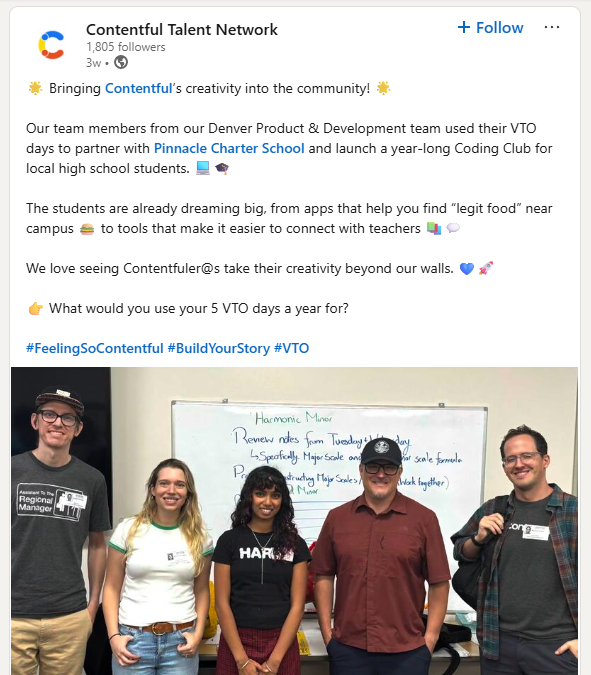Marketing Volunteer Time Off to Supporters at Your Nonprofit
Could the solution to your nonprofit’s volunteer shortage already exist within the workplaces around you? It’s estimated that more than half of large U.S. companies, including nearly all Fortune 500 firms, now offer Volunteer Time Off (VTO) to their employees. Yet, the vast majority of nonprofits are not strategically marketing these VTO opportunities to supporters, missing out on a vital source of skilled, motivated help.
For nonprofit volunteer coordinators, this is a pressing problem. Relying solely on your traditional volunteer base can leave you grappling with unpredictable event attendance and last-minute gaps. With support needs on the rise, organizations are searching for more reliable, scalable volunteer pipelines. That’s why marketing volunteer time off to supporters at your nonprofit has become such a timely, high-impact strategy.
In this post, we’ll show you actionable strategies that make corporate volunteer outreach successful. You’ll learn how to:
- Identify and map VTO opportunities for your organization
- Optimize volunteer roles to appeal to corporate teams
- Craft messaging that drives action, not just interest
- Build strategic relationships with companies to secure ongoing support
- Harness digital marketing and internal ambassadors for greater reach
- Collect data and feedback to improve your efforts continually
Engaging corporate volunteers through VTO programs isn’t just about filling schedules. It also helps you build stronger community partnerships and diversify your outreach methods. You can meet your goals more sustainably while offering a rewarding experience to supporters who want to give back but feel crunched for time.
Let’s dive into the proven approaches that can help your cause thrive while making volunteer recruitment easier and more consistent.
Understanding VTO and Mapping Opportunities
What is Volunteer Time Off, and Why Should Nonprofits Care?
Volunteer Time Off (VTO) is a benefit many employers offer, allowing staff to receive paid time off for volunteering with charitable causes. This program is mainstream among large employers, but many nonprofits don’t take full advantage of it. Engaging corporate employees through VTO can close service gaps, increase skilled volunteer participation, and strengthen your organization’s ties to the local business community.
Action Step: Start by researching which employers in your area offer volunteer time off. Tools like LinkedIn, local business associations, and corporate volunteer platforms can help you identify these companies. For a streamlined search process, consider using resources like Double the Donation’s corporate giving database, which makes it easy to discover corporate volunteer opportunities in your area.
Identify High-Potential Partners with a Tracker
Not every local employer has a VTO program, and even those who do may have specific requirements or focus areas. Therefore, it’s a good idea to create and maintain a spreadsheet with details for each company, including:
- Company name and number of employees
- VTO program details (hours allowed, types of volunteering supported)
- Key contacts for community programs or HR
- Notes on past or ongoing partnerships
- Links to relevant VTO program information
From there, you can prioritize companies known for community engagement or those with active social responsibility campaigns.
Real-World Example: PBS Wisconsin encouraged volunteers to check if their employers offered VTO and to connect their HR departments with the nonprofit. Using LinkedIn, they identified new potential partners and filled critical volunteer needs more effectively.
Sync Your Events with Corporate VTO Cycles
Companies often encourage employees to use VTO around recognized events, such as National Volunteer Week or during end-of-year team initiatives. Review your event and program calendar to identify high-need times and match them with local VTO cycles.
As you do so, make sure to:
- Highlight these periods in communications with corporate partners.
- Offer a calendar of VTO-friendly volunteering opportunities to targeted employers.
- Invite companies to pledge support during these peak periods.
Evaluate Your Readiness for Corporate Volunteers
Corporate VTO groups often arrive as teams, have specific skill sets, and appreciate efficiency. Make sure your organization is prepared to make the most of this resource by assessing:
- Your capacity to onboard teams or skilled professionals
- The flexibility of your volunteer shifts and scheduling
- Existing procedures for orientation, safety briefings, and feedback collection
Fine-tuning your operations to handle these needs will ensure a positive experience for both your organization and volunteers.
Optimizing Your Volunteer Offerings for Corporate Support
Develop Roles for Different Types of Corporate Volunteers
Corporate volunteers come in many forms; some participate as individuals, others as entire teams, and some seek roles that leverage their specific expertise. To attract them effectively, consider the following best practices:
- Create Group Projects: Break large initiatives, such as event setup or donation sorting, into projects for teams, ensuring tasks can be completed within a day. Group-friendly roles are appealing to companies looking for team-building opportunities.
- Offer Skills-Based Volunteering: Develop positions for IT, financial planning, marketing, law, or HR professionals. Promote these roles as exclusive projects for corporate teams interested in using their professional expertise to make an impact.
- Provide Flexible Shifts: Recognize that professionals may only have a half-day, a single day, or an afternoon available. Therefore, offer short-term and virtual tasks whenever possible.
Here’s an example: The Contentful Talent Network collaborated with Pinnacle Charter School, enabling employees to use VTO to launch a student coding club. This partnership increased student access to technology education and allowed the company to support the local community in a targeted way.
Streamline the Sign-Up and Orientation Process
Companies often have limited time for complicated volunteer onboarding. Therefore, make sure your volunteer sign-up process is clear and simple.
- Use user-friendly platforms that integrate seamlessly with your website.
- Provide a central contact (email and phone) for all corporate group inquiries.
- Send prompt confirmation emails and event reminders to reduce no-shows.
Then, consider preparing digital or print welcome kits that outline event details, parking, safety guidelines, and your organization’s mission. Offer tailored orientations for professional groups to help create a positive first impression. Highlight examples of your organization’s work with previous corporate groups and showcase the real outcomes of their support.
Build Feedback into the Process for Improvement
After each volunteer engagement, collect feedback from both volunteers and company HR contacts. Here are a few quick ideas for doing so:
- Send a quick survey or feedback form immediately after the event.
- Review responses with your team and adjust onboarding, assignments, or follow-up as needed.
These steps build lasting relationships and demonstrate that your nonprofit values partner input.
With your volunteer roles optimized, clear onboarding established, and VTO packets in hand, the next challenge is crafting messaging that converts interest into signups.
Crafting Messaging That Converts Supporters
Personalize Outreach for Maximum Impact
Your supporters are not a monolithic group, and your messaging should reflect that. For the best results, segment your lists for donors, community volunteers, employees at top VTO companies, and HR leaders. Use targeted emails or direct messages that speak directly to each audience’s motivations.
- For donors, highlight how their VTO hours can multiply their support of your organization
- For HR leaders, focus on benefits like employee engagement, team-building, and public recognition
By sending relevant messages at the right times, you increase your chances of a positive response.
Highlight Shared Value and Real Impact
Corporate volunteers want to know that their time is making a difference for your organization and for them personally or professionally. Emphasize mutual benefits in your communications by stating explicit impacts and organizational outcomes.
- Share success stories and testimonials from corporate volunteers
- Quantify impact with clear metrics (“Your support last month helped distribute 500 meals”)
- Show opportunities for publicity, such as social media features or recognition events
For example, Progressive frequently highlights its employees’ VTO participation on LinkedIn. Nonprofits featured in these posts gain reputation benefits and are more likely to attract future corporate support.

Use Strong, Action-Oriented Calls to Action
Busy professionals respond to specific, clear asks. For the best results, use direct language and time-sensitive prompts. Here are a few helpful examples:
- “Register your team for our May Day of Service by April 15.”
- “Download our Corporate Volunteer Guide to get started.”
- “Nominate your business to be featured in our Community Champions Hall of Fame.”
You should also offer multiple ways for people to get involved (e.g., single-day, group, or ongoing mentorship) so supporters can engage at any level.
Leverage Social Proof and Stories
Testimonial stories and photos from real VTO participants build credibility and help newcomers visualize their own involvement. Here are a few ways you can do so:
- Post before-and-after photos, share volunteer quotes, and publish mini-case studies across your channels
- Encourage supporters to tag your organization on LinkedIn when posting about their volunteer experiences
With persuasive, clear messaging ready, you can now focus on building partnerships that ensure recurring corporate support for your nonprofit.
Building Partnerships with Corporate VTO Programs
Network Strategically with Businesses and HR Leaders
Proactive, in-person, and virtual networking builds trust and opens doors to new VTO partners. Check out these ideas for getting involved:
- Attend local Chamber of Commerce meetups, nonprofit volunteer fairs, and business expos.
- Offer to host “lunch and learn” sessions at workplaces to educate employees about your nonprofit’s VTO opportunities.
Overall, you want to make your VTO materials and contact information available on your website. Regularly update this content so HR contacts can easily share it with employees.
Become a Preferred Partner Through Recurring Engagements
Companies often prefer partnering with nonprofits that offer reliable, recurring volunteer opportunities. For example, you might:
- Offer regular, pre-scheduled volunteer days or “signature” events aligned with corporate calendars.
- Give partner companies early access to high-profile volunteer events and recognition on your digital channels.
From there, be sure to maintain a list of preferred partners and highlight them in your outreach materials. Public recognition, such as annual awards or social media shout-outs, boosts corporate loyalty and engagement.
Gather Feedback and Co-Create New Projects
Partnership longevity comes from listening and adapting. Collecting feedback from both HR and participating employees allows you to:
- Refine logistics, communications, and project types for next time
- Invite feedback on future activities, such as new services or skills-based opportunities
- Encourage companies to co-sponsor or pilot special projects, which deepens their commitment
Solid corporate partnerships set the stage for scalable growth. The next frontier is digital marketing and activating internal champions to broaden your reach.
Leveraging Digital Marketing and Internal Champions
Expand Reach with Targeted Digital Campaigns
Digital marketing is a powerful tool for reaching prospective VTO volunteers. For the best results, focus on platforms where corporate employees spend time, such as LinkedIn and local business forums. From there, you can:
- Publish VTO opportunities with relevant hashtags and employer tags
- Boost high-impact posts to reach employees at targeted companies
- Share event highlights and volunteer testimonials with visuals for greater engagement
For greater reach, invest in sponsored posts targeting HR decision-makers or specific industry sectors.
Highlight Success Stories and Impact on Your Website
Be sure to update your nonprofit’s website frequently with fresh content about corporate volunteer success. Create a dedicated section on your Volunteers page or a separate VTO landing page that includes:
- Recent group photos and impact statistics regarding corporate volunteer involvement
- Volunteer spotlights or “Corporate Volunteer of the Month” posts
- Downloadable guides for businesses interested in team volunteering
These steps make it easy for both employees and HR leaders to learn about your offerings and share them internally.
Activate and Equip Internal Champions
Your previous VTO volunteers can be some of your greatest evangelists. Encourage them to:
- Share their experience in company newsletters or on social media
- Use the provided templates for LinkedIn or internal emails to spread the word
- Participate in a “bring a colleague” referral program, with small incentives or recognition for those who recruit new volunteers
For example, an IT professional volunteers for a day, shares her story in the company Slack channel, and inspires her department to form a team for an upcoming event.
By empowering supporters to advocate for your cause within their organizations, you unlock a network effect that multiplies volunteer engagement.
Collaborate on Content and Promotion
Coordinate with your partner companies’ communications teams to co-promote events through their official channels.
- Provide them with ready-to-share posts, photos, and event recaps
- Tag corporate partners on your social accounts, boosting visibility for your campaigns
With your reach expanded digitally and internally, your next step is to measure what’s working and refine for even better results.
Measuring and Iterating for Sustained Success
Set and Track Key Performance Metrics
Success in marketing volunteer time off to supporters at your nonprofit starts with tracking your outreach and engagement. Use tools like spreadsheets, CRMs, or dedicated volunteer management software to record KPIs, such as:
- Number of VTO inquiries and sign-ups
- Hours completed by corporate volunteers
- Repeat participation rates
- Performance data from digital marketing campaigns (click-through rates, conversions, shares)
You can also use platforms like Double the Donation to collect volunteer employer names and compare your results with other community organizations.
Collect Feedback from All Stakeholders
Continuous feedback helps you refine your strategies and improve the volunteer experience, making it more rewarding for everyone involved. To access volunteers’ thoughts on your programs, try:
- Sending quick post-event surveys to volunteers and HR managers
- Including specific questions about onboarding, logistics, and perceived impact
- Using quarterly check-ins with recurring partners to discuss areas for improvement
This approach ensures both you and your partners feel heard and helps surface new opportunities.
Share Results and Recognize Success Publicly
Regular reporting back demonstrates the value of corporate support and encourages ongoing community involvement. This can include:
- Share impact reports featuring volunteer numbers, key outcomes, and memorable stories
- Publicly thank high-performing partners and volunteers in newsletters or on social media
- Update your VTO packets and guides annually to reflect the latest data
Highlight progress toward goals, such as increased VTO participation each year or new milestones in your volunteer program.
Iterate and Improve Your Volunteer Time Off Program
As you go along, be sure to analyze your results to identify what’s working best and where you can do better. This could include:
- Revise your digital campaigns and messaging for channels with the highest engagement
- Adapt volunteer roles and event formats to feedback from corporate teams
- Expand or sunset specific outreach strategies based on measurable success
By embedding review and improvement into your VTO marketing, you ensure sustainable growth and maximize your nonprofit’s community impact.
Conclusion
Marketing volunteer time off to supporters at your nonprofit will help fill volunteer gaps and create a powerful network of local business partners. By identifying and tracking VTO opportunities, optimizing your volunteer programs, refining your messaging, building strategic partnerships, extending your digital reach, and consistently measuring your results, you can create a steady stream of engaged corporate volunteers.
The key is to treat VTO engagement as a comprehensive, evolving strategy: one that benefits your organization, your corporate partners, and the greater community. By following the actionable steps outlined in this post, your nonprofit can boost impact, win new supporters, and inspire lasting community change.
Ready to put these strategies into action? Download Double the Donation’s free VTO guide, or explore other resources on how to grow volunteer engagement and revenue, easily discover corporate volunteer opportunities, and collect volunteer employer names to maximize your program’s success.



